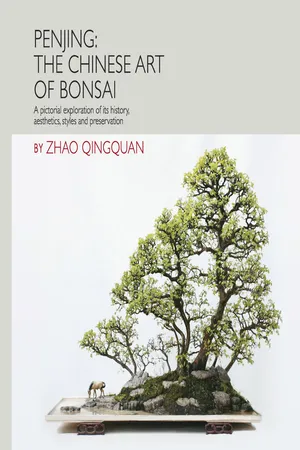
eBook - ePub
Penjing: The Chinese Art of Bonsai
A Pictorial Exploration of Its History, Aesthetics, Styles and Preservation
- English
- ePUB (mobile friendly)
- Available on iOS & Android
eBook - ePub
Penjing: The Chinese Art of Bonsai
A Pictorial Exploration of Its History, Aesthetics, Styles and Preservation
About this book
With hundreds of color photographs and illustrations, this Chinese gardening book is a wonderful introduction to penjing—China's treasured bonsai art. Although most people thing bonsai is a Japanese invention, the art originated in ancient China where it is called penjing. The two Chinese characters for penjing ("pot" and "landscape") capture the essence of this art: sculpting microcosms of the beauty of the natural world from plants, rocks, soil, and water, both as an artistic process and as horticultural cultivation. Both penjing and bonsai are art forms that express the beauty of nature. In China, bonsai, as a part of penjing, is often called "tree penjing," or "tree in a pot." The Chinese divide penjing into three categories: tree penjing, rock penjing, and water-and-land penjing. This Chinese gardening book showcases the Chinese art of penjing in all its aspects for the benefit of penjing aficionados and all other readers interested in Chinese culture. It covers the concept, history, categories, aesthetic features, techniques, display, appreciation, and preservation of penjing. It is a feast for the eyes while providing a wealth of information for the academically inclined as well as the practically minded. There are more than 300 lavish illustrations grouped into three different categories of penjing. The reader will not only be awed by the beautiful compositions of penjing, but will also learn about the Chinese approach to nature and to life.
Frequently asked questions
Yes, you can cancel anytime from the Subscription tab in your account settings on the Perlego website. Your subscription will stay active until the end of your current billing period. Learn how to cancel your subscription.
At the moment all of our mobile-responsive ePub books are available to download via the app. Most of our PDFs are also available to download and we're working on making the final remaining ones downloadable now. Learn more here.
Perlego offers two plans: Essential and Complete
- Essential is ideal for learners and professionals who enjoy exploring a wide range of subjects. Access the Essential Library with 800,000+ trusted titles and best-sellers across business, personal growth, and the humanities. Includes unlimited reading time and Standard Read Aloud voice.
- Complete: Perfect for advanced learners and researchers needing full, unrestricted access. Unlock 1.4M+ books across hundreds of subjects, including academic and specialized titles. The Complete Plan also includes advanced features like Premium Read Aloud and Research Assistant.
We are an online textbook subscription service, where you can get access to an entire online library for less than the price of a single book per month. With over 1 million books across 1000+ topics, we’ve got you covered! Learn more here.
Look out for the read-aloud symbol on your next book to see if you can listen to it. The read-aloud tool reads text aloud for you, highlighting the text as it is being read. You can pause it, speed it up and slow it down. Learn more here.
Yes! You can use the Perlego app on both iOS or Android devices to read anytime, anywhere — even offline. Perfect for commutes or when you’re on the go.
Please note we cannot support devices running on iOS 13 and Android 7 or earlier. Learn more about using the app.
Please note we cannot support devices running on iOS 13 and Android 7 or earlier. Learn more about using the app.
Yes, you can access Penjing: The Chinese Art of Bonsai by Qingquan Zhao in PDF and/or ePUB format, as well as other popular books in Biological Sciences & Horticulture. We have over one million books available in our catalogue for you to explore.
Information
Table of contents
- Cover
- Title Page
- Copyright
- Contents
- Foreword by Rob Kempinski
- Preface
- Chapter One: Penjing Aesthetics
- Chapter Two: History of Penjing
- Chapter Three: Basic Penjing Techniques
- Chapter Four: Categories and Designs
- Chapter Five: Displaying Techniques
- Chapter Six: Care and Maintenance